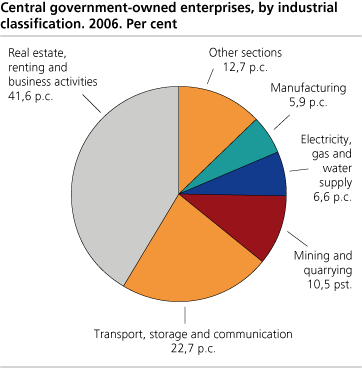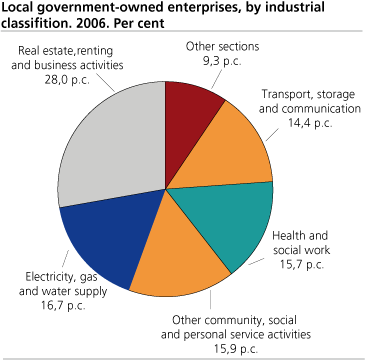Content
Published:
This is an archived release.
Real estates and business activities dominate
There were approximately 2 630 public owned non-financial enterprises by the end of 2006. About 2 070 enterprises, or 78.7 per cent, were local government owned enterprises, while the rest was owned by the central government. Real estates and business activities is the classification area with most non-financial enterprises
Mostly, the 560 central government owned enterprises were organised in the five major industrial classification areas. These were real estates activities and business activities (41.6 per cent), transport and communication (22.7 per cent), mining and extraction (10.5 per cent), energy and water supply (6.6 per cent) and industry (5.9 per cent).
Local government owned enterprises, which constitute 78.8 per cent of the non-financiel enterprises, operated in five major industrial classification areas. These were real estates activities and business activities (28.0 per cent), energy and water supply (16.7 per cent), other social and personal services (15.9 per cent), health and social services (15.7 per cent) and transport and communication (14.4 per cent).
The number of public owned non-financial enterprises has been changing during the recent years. One explanation for the recent development is the fact that some of the major enterprises have been reorganised either by take over or divestiture. Changes in Statistics Norway's information about ownership structure in the enterprises in 2003 and 2004 affected the increase.
Major business organisation forms
Mostly, the central government owned enterprises were organised as limited companies or public limited companies. About 531 enterprises or 94.8 per cent had this type of business organisation form by the end of 2006 and this has been relatively stable during the period.
Some what 1 588 or 76.5 per cent local government owned enterprises were organised as limited companies by the end of 2006. Other common form of companies include municipal or county municipal enterprises, local government companies incorporated by the local government Act and inter municipal enterprises.
Geographical concentration
Most of the central government owned enterprises were located in the four major counties; Oslo, Akershus, Rogaland and Sør Trøndelag by 134, 94, 86 and 65 enterprises respectively. Generally, about 67 per cent of the central government owned enterprises were geographically located in these four counties. About 40 per cent the total population was registered in Oslo and Akershus.
The basis of the computationThe statistics comprises public owned non-financial enterprises. An enterprise is defined as public owned if the majority shareholder in the enterprise directly or indirectly belongs to the central government or the local government. A local government enterprise can be owned by a municipality or by a county municipality.
The statistics also covers municipal and county municipal companies, inter-municipal companies and companies incorporated by the local government Act. One or more local government wholly owns these business entities. Inter municipal companies belong in the municipality where the head office is located. |
Tables:
- Table 1 Public non-financial corporation. Number. 2001-2006
- Table 2 Central government-owned enterprises, by industrial classification. 2001-2006. Number and per cent
- Table 3 Local government-owned enterprises, by industrial classification. 2001-2006. Number and per cent
- Table 4 Central government-owned enterprises, by organizational structure. 2001-2006. Number and per cent
- Table 5 Local government-owned enterprises, by organizational structure. 2001-2006. Number and per cent
- Table 6 Central government-owned enterprises, by county. 2001-2006. Number and per cent
- Table 7 Local government-owned enterprises, by county. 2001-2006. Number and per cent
Contact
-
Statistics Norway's Information Centre
E-mail: informasjon@ssb.no
tel.: (+47) 21 09 46 42


